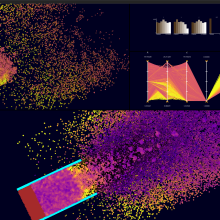The Visualization Research Center (VISUS) at the University of Stuttgart is pleased to announce that it is expanding its Intel Graphics and Visualization Institute of Xellence (Intel GVI) to an Intel oneAPI Center of Excellence (CoE) focusing on cross-architecture in-situ visualization across CPUs, GPUs, and other accelerators. The center will use oneAPI’s heterogeneous programming and Intel® oneAPI Rendering Toolkit for advanced ray tracing and parallelization capabilities to evolve the scalable, in situ capable backend of the visualization framework MegaMol, which helps study and understand physical processes in fields like thermodynamics and porous media research.
A flexible framework for diverse visualization scenarios
MegaMol is a visualization framework designed for interactivity with a strong focus on molecular visualization. It has been steadily extended to also support scalar and vector fields, as well as multi-faceted analysis via linked views and additional visualization techniques for non-spatial data. MegaMol supports both desktop-centric post-hoc visualization and HPC cluster in-situ simulation plus visualization usages. It is aimed at visualization prototyping and fundamental visualization research, and has been used for visualization of diverse data on a range of scales, from thermodynamics and biochemistry over porous media and captured point clouds all the way up to cosmological simulations. It has close ties to the open-source molecular dynamics simulation program ls1 mardyn, twice holder of the world record for largest molecular dynamics simulation. MegaMol is the basis of over 50 scientific publications and a three-time winner of the scientific visualization contest at IEEE Vis.
In situ capabilities and scalable approaches for heterogeneous hardware
The original scope and design goal of MegaMol for desktop platform use is proven to be a valuable asset and basis for fundamental and applied visualization research, both for static data and time series. With current trends shifting to ever-growing simulations and needs for simulation monitoring and visualization that does not rely on terabytes of stored data, a more generic, hardware-independent in situ usage scenario was required. With the help of Intel and the open-source Intel® oneAPI Rendering Toolkit, the Visualization Research Center has evolved the available rendering paradigms from immediate modular rendering requiring GPU acceleration. They combined the MegaMol visualization graph with the retained scene graph of Intel® OSPRay into an advanced rendering backend. Intel OSPRay’s built-in scalability broadens useful hardware platforms significantly, from single node to supercomputers. It also provides high-fidelity imagery to showcase research.
Research associate Dr. Guido Reina is leading the MegaMol development. Their research team and other colleagues who use and develop MegaMol have benefited greatly from this collaboration. “The international network of Intel and its academic partners is extremely valuable for the exchange of expertise,” says Reina. “It also gives us access to various deployed platforms for developing and testing our framework and visualization approaches, such as the Texas Advanced Computing Center, which provides friendly, no-fuss support and ample testing opportunities. We are continuously extending our collaborations with other institutions to funnel expertise into developing novel and useful features in our framework. Together, these motivated teams push the envelope of technical capabilities and visualization all the time.”
Prof. Dr. Thomas Ertl, VISUS director and spokesperson of the Cluster of Excellence EXC 2075 Data-Integrated Simulation Science, states: “This is a great opportunity for us to renew our efforts for developing novel approaches that are quintessentially open source and available to everyone. The oneAPI Center of Excellence will help us pursue our goals.”
“Our long-standing collaborations delivering insights in particle rendering, molecular dynamics and thermodynamics research with Prof. Ertl and Dr. Reina’s team at VISUS continues to grow stronger. Extending and easing that work through oneAPI cross-architecture development and advanced ray tracing on multiple types of architectures bypasses proprietary programming constraints and unleashes opportunities for advancing research through MegaMol,” says Jim Jeffers, senior principal engineer and senior director of Intel Advanced Rendering and Visualization.
About oneAPI: oneAPI is an open, unified and cross-architecture programming model for CPUs and accelerator architectures (GPUs, FPGAs, and others). Based on standards, the programming model simplifies software development and delivers uncompromised performance for accelerated compute without proprietary lock-in, while enabling the integration of legacy code. With oneAPI, developers can choose the best architecture for the specific problem they are trying to solve without needing to rewrite software for the next architecture and platform.
About Intel® oneAPI Rendering Toolkit
The Intel® oneAPI Rendering Toolkit is a set of open source libraries that enables creation of high-performance, high-fidelity, extensible, and cost-effective visualization applications and solutions. Its libraries provide rendering kernels and middleware for Intel® platforms for maximum flexibility, performance, and technical transparency. The toolkit supports Intel CPUs and future Xe architectures (GPUs). It includes the award-winning Intel® Embree, Intel® Open Image Denoise, Intel® Open Volume Kernel Library, Intel® OSPRay, Intel® OpenSWR and other components and utilities.
© Intel Corporation. Intel, the Intel logo, and other Intel marks are trademarks of Intel Corporation or its subsidiaries.
| Contact | Dr. Guido Reina |
|---|



